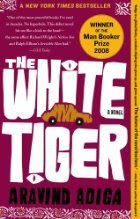 When you have heard the story of how I got to Bangalore and become one of its most successful (though probably least known) businessmen, you will know everything there is to know about how entrepreneurship is born, nurtured, and developed in this, the glorious twenty-first century of man. The century, more specifically, of the yellow and brown man. - from The White Tiger, page 4 -
When you have heard the story of how I got to Bangalore and become one of its most successful (though probably least known) businessmen, you will know everything there is to know about how entrepreneurship is born, nurtured, and developed in this, the glorious twenty-first century of man. The century, more specifically, of the yellow and brown man. - from The White Tiger, page 4 -Balram Halwai is the mocking, pathological narrator of Aravind Adiga’s Booker winning novel The White Tiger. Born in the Darkness - the underbelly of India - and destined from childhood to be a servant, he tells his story in a series of letters over a seven day period to Wen Jiabao, the Premier of China. A self-described entrepreneur and philosopher, Balram explains how he has come to see himself as a white tiger.
The inspector pointed his cane straight at me. “You, young man, are an intelligent, honest, vivacious fellow in this crowd of thugs and idiots. In any jungle, what is the rarest of animals - the creature that comes along only once in a generation?”
I thought about it and said:
“The white tiger.”
“That’s what you are, in this jungle.”
- from The White Tiger, page 30 -
It is this inner view of himself - a rare creature in a savage world - which drives him eventually to murder his master and take charge of his life.
Even as a boy I could see what was beautiful in the world: I was destined not to stay a slave. - from The White Tiger, page 35 -
Adiga has created a not wholly likeable protagonist to narrate the story of an India which is sharply divided between the very rich (and corrupt) and the very poor. The cynical voice of Balram jeers at democracy and uncovers the dark, corrupt world of the wealthy upper class. He pokes fun at China who despite their triumphs ‘in sewage, drinking water, and Olympic gold medals, still don’t have democracy.‘
Adiga uses an analogy of roosters in the coop to describe the servant’s (or poor man’s) inescapable status in India.
They see the organs of their brothers lying around them. They know they’re next. Yet they do not rebel. They do not try to get out of the coop. - from The White Tiger, page 147 -
But for Balram, there is a way out - one of his own making. He resists the pull of family obligation and loyalty to his master and plans his escape through cold-blooded murder.
[...] only a man who is prepared to see his family destroyed - hunted, beaten, and burned alive by the masters - can break out of the coop. - from The White Tiger, page 150 -
Rage is what fuels Balram to break free of his caste and become a successful businessman. He takes his destiny into his own hands and does what he feels he must to become a free man. And in the end, he concludes there is really no difference between a man and a demon - only that one has woken up and the other is still sleeping. The message seems to be that there is no good anywhere in India. It is no wonder that Indians have been critical of this novel.
The White Tiger is an interesting story - one that is compelling and blackly humorous despite its negative message. It is a scathing commentary on the divide between the poor and the rich, the benevolent and the corrupt - but, it is ultimately just a very good yarn.
Recommended.
![]()
Read an interview with Adiga.
No comments:
Post a Comment